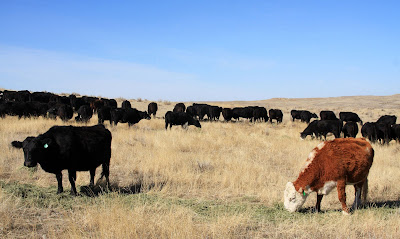 This Hereford cow is the last of her kind on our operation, and she will be sold this fall because of her age. There was a time, about 25 years ago, when this picture would have looked opposite the way it does now. By that I mean there would have been one or two black cows, and the rest would have been Herefords.
This Hereford cow is the last of her kind on our operation, and she will be sold this fall because of her age. There was a time, about 25 years ago, when this picture would have looked opposite the way it does now. By that I mean there would have been one or two black cows, and the rest would have been Herefords.She is a cow of note because she represents the basis from which all these black cows were derived. Most operations in the west were strictly Hereford a couple decades ago, but things change fast in agriculture, and the shift from a Hereford to Angus commercial cowherd in the U.S. is one prime example of this.
Why this shift? Well, there are a few reasons. One is the Angus breed did a far superior job marketing their breed, and created a demand for (black) Angus cattle that far exceeded the demand for any other single breed. The Angus breed also started collecting lots of data, and provided this to producers to help in their breeding decisions.
Another reason is the Hereford breed isn't perfect, and a few of the problems are especially irritating, and practically non-existent in Angus cows. These include cancer eyes, prolapsing, sunburnt bags, horns and calves that didn't get right up and suck like Angus calves.
I have personally been involved in a couple blizzards that resulted in us milking our Hereford range (read-not tame) cows twice a day for two weeks. This had to be done because after the cow's bags (udders) were sunburned, it hurt to have their calves suck, so they kicked them off. If we hadn't milked them, the milk in their bags would have gone sour, and ruined them, as in they wouldn't produce milk anymore. So we ran them all through our chute, twice a day, and milked them, then applied bag balm to ease their pain. Meanwhile we were also bottle feeding several of their calves.
Just another example of what we're willing to do for the health of our livestock.
But, dealing with issues like this make Angus cows look alright in comparison, as their black pigmented bags don't get sunburned, you don't have to dehorn their calves, and they don't prolapse or get cancer eyes nearly as frequently.
(I'm getting to the plus side for you Hereford lovers out there)
Now, don't get me wrong, I really like the Hereford breed, and they have really good things going for them too. A Hereford cow is typically in better shape than her similarly managed black counterparts. This means she will raise a calf, breed back, and not be skin and bones in the fall. They're also a mellower breed disposition wise, and it's hard to beat a big black baldy calf.
As for a positive Hereford story, I have several. My first show heifer was a Hereford, and my grandpa took a load of Hereford steers to Denver in the earlier 1900's that made the paper and were said to be the best load of steers to go through the Stockyards to date.
But, while the Angus cow isn't perfect either, she quickly gained popularity for her color, quality, vigor and the amount of data backing her, in addition to other reasons depending on who you talk to.
Demand for Hereford cattle plummeted, and as a result the Hereford breed has worked hard to cull out the animals responsible for those negative traits. It's a whole new Hereford breed today, and several people are starting to go back to Hereford bulls to take advantage of the heterosis, or hybrid vigor, and the all-around good cross a Hereford and Angus pairing results in.

I'm one of those people that would like to use some Hereford genetics on our black cows, due largely to my love of black baldy cows. But, for now, my dad is hanging tough with Angus bulls, and I'm fine with that too. But this cow is a great cow of note, because she represents where our herd came from, and it's a great history.

No comments:
Post a Comment